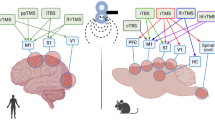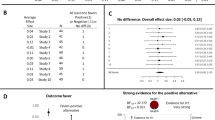The effects of transcranial electrical stimulation (TES) of the brain on word learning were addressed in a large-scale study in 288 people. The study included a comprehensive assessment of the effects of TES in various conditions (implicit/explicit learning strategy, with/without articulation, anodic/cathodic stimulation, left/right hemisphere, and stimulation area (Broca/Wernicke and their homologs in the right hemisphere)). After 15 minutes of real or placebo stimulation, subjects were presented with eight new words with semantic binding, each 10 times. The latency of correct responses in the test task assessing the semantic correlation of the word and image was used as an indicator of the effectiveness of acquiring new words. The results showed a general non-specific acceleration of responses when real stimulation was used (as compared to placebo), independently of the conditions tested.
Similar content being viewed by others
References
Brückner, S. and Kammer, T., “Both anodal and cathodal transcranial direct current stimulation improves semantic processing,” Neuroscience, 343, 269–275 (2017).
Cocquyt, E. M., De Ley, L., Santen, P., et al., “The role of the right hemisphere in the recovery of stroke-related aphasia: A systematic review,” J. Neurolinguistics, 44, 68–90 (2017).
Dedoncker, J., Brunoni, A. R., Baeken, C., and Vanderhasselt, M. A., “A systematic review and meta-analysis of the effects of transcranial direct current stimulation (tDCS) over the dorsolateral prefrontal cortex in healthy and neuropsychiatric samples: Influence of stimulation parameters,” Brain Stimul., 9, No. 4, 501–517 (2016).
Elmer, S., Burkard, M., Renz, B., et al., “Direct current induced short-term modulation of the left dorsolateral prefrontal cortex while learning auditory presented nouns,” Behav. Brain Funct., 5, No. 1, 29 (2009).
Fiori, V., Cipollari, S., Caltagirone, C., and Marangolo, P., “’If two witches would watch two watches, which witch would watch which watch?’ tDCS over the left frontal region modulates tongue twister repetition in healthy subjects,” Neuroscience, 256, 195–200 (2014).
Flöel, A., Rösser, N., Michka, O., et al., “Noninvasive brain stimulation improves language learning,” J. Cogn. Neurosci., 20, No. 8, 1415–1422 (2008).
Gurskaya, O. A., Altynbaev, R. Sh., and Kudryashov, I. E., “Effects of the prolonged action of direct electric fi elds on the rat brain,” Zh. Vyssh. Nerv. Deyat., 62, No. 1, 79–88 (2011).
Horvath, J. C., Forte, J. D., and Carter, O., “Evidence that transcranial direct current stimulation (tDCS) generates little-to-no reliable neurophysiologic effect beyond MEP amplitude modulation in healthy human subjects: A systematic review,” Neuropsychologia, 66, 213–36 (2015).
Malyutina, S. and den Ouden, D. B., “High-defi nition tdcs of noun and verb retrieval in naming and lexical decision,” NeuroRegulation, 2, 111–125 (2015).
Pisoni, A., Cerciello, M., Cattaneo, Z., and Papagno, C., “Phonological facilitation in picture naming: When and where? A tDCS study,” Neuroscience, 352, 106–121 (2017).
Pisoni, A., Vernice, M., Iasevoli, L., et al., “Guess who? Investigating the proper name processing network by means of tDCS,” Neuropsychologia, 66, 267–278 (2015).
Shelyakin, A. M. and Preobrazhenskaya, I. G., “Micropolarization of the brain,” in: Yesterday. Today. Tomorrow (2021).
Shtyrov, Y., Filippova, M., Blagovechtchenski, E., et al., “Electrophysiological evidence of dissociation between explicit encoding and fast mapping of novel spoken words,” Front. Psychol., 12, 571673 (2021).
Tomczak, M. and Tomczak, E., “The need to report effect size estimates revisited. An overview of some recommended measures of effect size,” Trends Sport Sci., 1, No. 21, 19–25 (2014).
Author information
Authors and Affiliations
Corresponding author
Additional information
Translated from Zhurnal Vysshei Nervnoi Deyatel’nosti imeni I. P. Pavlova, Vol. 72, No. 2, pp. 227–232, March–April, 2022.
Rights and permissions
Springer Nature or its licensor (e.g. a society or other partner) holds exclusive rights to this article under a publishing agreement with the author(s) or other rightsholder(s); author self-archiving of the accepted manuscript version of this article is solely governed by the terms of such publishing agreement and applicable law.
About this article
Cite this article
Filippova, M.G., Perikova, E.I., Blagovechtchenski, E.D. et al. The Nonspecific Positive Actions of Direct Current Transcranial Electrical Stimulation on Novel Word Acquisition. Neurosci Behav Physi 52, 1254–1257 (2022). https://doi.org/10.1007/s11055-023-01354-3
Received:
Accepted:
Published:
Issue Date:
DOI: https://doi.org/10.1007/s11055-023-01354-3




